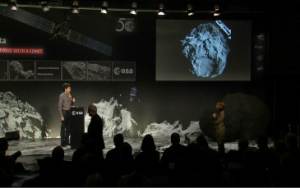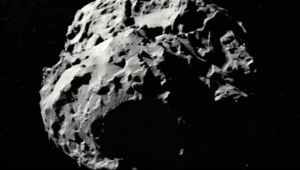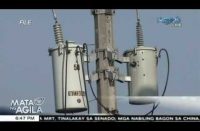
(Reuters) — The Philae probe on Wednesday (November 12) released a close-up image of Comet 67P/Churyumov-Gerasimenko as the European Space Agency (ESA) said on-board instruments are working despite the anchors not working as planned.
The picture, taken with the lander’s ROLIS camera, was taken 3km away from the target during the craft’s descent.
Philae’s landing marks a first in space exploration and the climax of a decade-long mission to examine up close the remnants of the birth of Earth’s solar system.
The 100-kg (220-pound) lander – virtually weightless on the comet’s surface – touched down on schedule at about 1600 GMT after a seven-hour descent from spacecraft Rosetta around half a billion kilometres (300 million miles) from Earth.
During the launch, harpoons designed to anchor the probe failed to deploy and the ESA is having to consider options for refiring them to ensure it does not drift back into space.
“We had a very clear signal there and we also received data from the lander, housekeeping data, and also science data. That’s the very good news. Not so good news is that the anchoring harpoons apparently did not fire. So the lander is not anchored to the surface. And now we started to think about what could be the situation – did we just land in a soft sandbox and everything is fine although we are not anchored and the ADS [Active Descent System] did not fire, or is there something else happening?” Philae lander manager from the German Aerospace Centre, Dr. Stephan Ulamec, said at a news conference.

Scientists hope that samples from the surface of 67P/Churyumov-Gerasimenko will help show how planets and life are created as the rock and ice that make up comets preserve organic molecules like a time-capsule.
Comets come from the formation of Earth’s 4.6-billion-year-old solar system and scientists believe they may have brought much of the water in Earth’s oceans.
Jubilant scenes welcomed the successful descent but the head of ESA Operations, Paolo Ferri, said the work had to go on.
“When I left the control room, everybody was moved, was excited, most of the people were crying. People are more, yeah, they have difficulties to believe that it happened, so, but we are very busy, the control team is busy in checking the situation, stabilising the situation, so they won’t have much time to think of the historical moment — they have to work,” he told journalists.
“Signs continue coming, of course the scientific experiments will start a bit later, but the measurements for the instruments which were already active — and they are already active now — are coming,” Ferri added.
Manmade craft have now landed on seven bodies in space: the moon, Mars, Venus, Saturn’s moon Titan, two asteroids and comet Tempel-1, which was hit by a NASA probe.
Among several records set by the mission, Rosetta has become the first spacecraft to orbit a comet rather than just flying past to take pictures.







